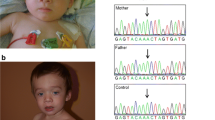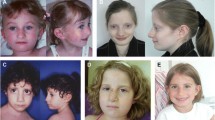Abstract
We describe the natural history of the RTSII phenotype in a 7-year-old boy who developed intrauterine and postnatal growth retardation, failure to thrive and persisting diarrhoea. The growth hormone stimulation test identified an isolated growth hormone deficiency. Since infancy, the patient manifested skin lesions characterized by a very mild poikilodermic-like appearance on the cheeks only, widespread café-au-lait spots and the absence of eyebrows and eyelashes. There was no cataract. Orthopaedic and radiologic work-up identified the absence of thumb anomaly and radial head luxation and patellar hypoplasia. Neurologic, cognitive milestones and intelligence were normal. The cytogenetic work-up did not show any anomaly. Based on this clinical presentation, we carried out a sequencing analysis of the RECQL4 gene, which is responsible for Rothmund-Thomson, RAPADILINO and Baller-Gerold syndromes and found a splice site mutation (IVS10-1G>A) and a nucleotide substitution in exon 12 (L638P). The mother was identified as a carrier for the substitution in exon 12 and the father for the splice site mutation, respectively. An analysis of the transcripts focused on the RECQL4 helicase domain: in the proband only those generated from the maternal L638 allele were present. This case report emphasizes the clinical overlap between RAPADILINO and Rothmund-Thomson syndromes within a continuum phenotypic spectrum. The distinctive set of clinical signs displayed by the patient may be accounted for by his unique combination of two different RECQL4 mutations. The molecular findings provide information that enhances our comprehension of genotype-phenotype correlations in RECQL4 diseases, enables a more precise genetic counseling to the parents and facilitates a more appropriate long-term follow-up to the affected child.



Similar content being viewed by others
References
Balraj P, Concannon P, Jamal R, Beghini A, Hoe TS, Khoo AS, Volpi L (2002) An unusual mutation in RECQL4 gene leading to Rothmund-Thomson syndrome. Mut Res 508:99–105
Beghini A, Castorina P, Roversi G, Modiano P, Larizza L (2003) RNA processing defects of the helicase gene RECQL4 in a compound heterozygous Rothmund-Thomson patient. Am J Med Genet 120A:395–399
Broom MA, Wang LL, Otta Sk, Knutsen AP, Siegfries E, Batanian JR, Kelly ME, Shah M (2006) Successful umbilical cord blood stem cell transplantation in a patient with Rothmund-Thomson syndrome and combines immunodeficiency. Clin Genet 69:337–343
Hilhorst-Hofstee Y, Shah N, Atherton D, Harper JI, Milla P, Winter RM (2000) Radial aplasia, poikiloderma and auto-immune enterocolitis-new syndrome or severe form of Rothmund-Thomson syndrome? Clin Dysmorphol 9:79–85
Jam K, Fox M, Crandall BF (1999) RAPADILINO syndrome: A multiple malformation syndrome with radial and patellar aplasia. Teratology 60:37–38
Kääriäinen H, Ryöppy S, Norio R (1989) RAPADILINO syndrome with radial and patellar aplasia/hypoplasia as main manifestations. Am J Med Genet 33:346–351
Kant SG, Baraitser M, Milla PJ, Winter RM (1998) RAPADILINO syndrome-a non-Finnish case. Clin Dysmorphol 7:135–138
Kellermayer R, Siitonen HA, Hadzsiev K, Kestilä M, Kostolanyi G (2005) A patient with Rothmund-Thomson syndrome and all features of RAPADILINO. Arch Dermatol 141:617–620
Kitao S, Ohsugi I, Ichikawa K, Goto M, Furuichi Y, Smimamoto A (1998) Cloning of two new human helicase genes of the RecQ family: Biological significance of multiple species in higher eukaryotes. Genomics 54:443–452
Kitao S, Shimamoto A, Goto M, Miller RW, Smithson WA, Lindor NM, Furuichi Y (1999) Mutations in RECQL4 cause a subset of cases of Rothmund-Thomson syndrome. Nat Genet 22:82–84
Larizza L, Magnani I, Roversi G (2006) Rothmund-Thomson syndrome and RECQL4 defect: splitting and lumping. Cancer Lett 232:107–120
Lindor NM, Devries EMG, Michels VV, Schad CR, Jalal SM, Donovan KM, Smithson WA, Kvols LK, Thibodeau SN, Dewald GW (1996) Rothmund-Thomson syndrome in siblings: evidence for acquired in vivo mosaicism. Clin Genet 49:124–129
Lindor NM, Furuichi Y, Kitao S, Shimamoto A, Arndt C, Jalal S (2000) Rothmund-Thomson syndrome due to RECQ4 helicase mutations: Report and clinical and molecular comparison with Bloom syndrome and Werner syndrome. Am J Med Genet 90:223–228
Macris MA, Krejci L, Bussen W, Shimamoto A, Sung P (2006) Biochemical characterization of the RECQ4 protein, mutated in Rothmund-Thomson syndrome. DNA Repair 5:172–180
Mégarbané A, Melki I, Souraty N, Gerbaka J, El Ghouzzi V, Bonaventure J, Mornand A, Loiselet J (2000) Overlap between Baller-Gerold and Rothmund-Thomson syndrome. Clin Dysmorphol 9:303–305
Miozzo M, Castorina P, Riva P, Dalprà L, Fuhrman Conti AM, Volpi L, Hoe TS, Khoo A, Wiegant J, Rosenberg C, Larizza L (1998) Chromosomal instability in fibroblasts and mesenchymal tumors from 2 sibs with Rothmund-Thomson syndrome. Int J Cancer 77:504–510
Mohaghegh P, Hickson ID (2001) DNA helicase deficiencies associated with cancer predisposition and premature ageing disorders. Hum Mol Genet 10:741–74
Mohaghegh P, Hickson ID (2002) Premature ageing in RecQ helicase-deficient human syndromes. Int J Biochem Cell Biol 34:1496–1501
Petkovic M, Dietschy T, Freire R, Jiao R, Stagljar I (2005) The human Rothmund-Thomson syndrome gene product, RECQL4, localizes to distinct nuclear foci that coincide with proteins involved in the maintenance of genome stability. J Cell Sc 118:4261–4269
Pujol LA, Erickson RP, Heidenreich RA, Cunniff C (2000) Variable presentation of Rothmund-Thomson syndrome. Am J Med Genet 95:204–207
Rothmund A (1868) Uber cataracten in Verbindung mit einer eigentumlichen Hautdegenearation. Arch Exp Ophtal 4:159–182
Siitonen HA, Kopra O, Kääriäinen H, Haravuori H, Winter RM, Säämänen AM, Peltonen L, Kestilä M (2003) Molecular defect of RAPADILINO syndrome expands the phenotype spectrum of RECQL diseases. Hum Mol Genet 12:2837–2844
Taylor WB (1957) Rothmund’s Syndrome-Thomson’s syndrome. Arch Dermatol 75:236–244
Thomson S (1936) Poikiloderma congenitale. Brit J Dermat Syph 5:220–234
Tong M (1995) Rothmund-Thomson syndrome in fraternal twins. Pediatr Dermatol 12:134–137
Van Maldergem L, Verloes A, Lejeune L, Gillerot Y (1992) The Baller-Gerold Syndrome. J Med Genet 29:266–268
Van Maldergem L, Siitonen HA, Jalkh L, Chouery E, De Roy M, Delague V, Muenke M, Jabs EW, Cai J, Wang LL, Plon SE, Fourneau C, Kestilä M, Gillerot Y, Mégarbané A, Verloes A (2006) Revisiting the craniosynostosis-radial ray hypoplasia association: Baller-Gerold syndrome caused by mutations in RECQL4 gene. J Med Genet 43:148–152
Vargas FR, Cabarel de Almeida J, Llerena JC Jr, Reis DF (1992) RAPADILINO syndrome. Am J Med Genet 44:716–719
Vennos EM, Collins M, James W (1992) Rothmund-Thomson syndrome: review of the world literature. J Am Acad Dermatol 27:750–762
Wang LL, Levy ML, Lewis RA, Chintagumpala MM, Lev D, Rogers M, Plon SE (2001) Clinical manifestations in a cohort of 41 Rothmund-Thomson syndrome patients. Am J Med Genet 102:11–17
Wang LL, Worley K, Gannavarapu A, Chintagumpala MM, Levy ML, Plon SE (2002) Intron-size constraint as a mutational mechanism in Rothmund-Thomson syndrome. Am J Hum Genet 71:165–167
Wang LL, Gannavarapu A, Kozinetz CA, Levy ML, Lewis RA, Chintagumpala MM, Ruiz-Maldanado R, Contreras-Ruiz J, Cunniff C, Erickson RP, Lev D, Rogers M, Zackai EH, Plon SE (2003) Association between osteosarcoma and deleterious mutations in the RECQL4 gene in Rothmund-Thomson syndrome. J Natl Cancer Inst 95:669–674
Author information
Authors and Affiliations
Corresponding author
Rights and permissions
About this article
Cite this article
Sznajer, Y., Siitonen, H.A., Roversi, G. et al. Atypical Rothmund-Thomson syndrome in a patient with compound Heterozygous Mutations in RECQL4 Gene and phenotypic features in RECQL4 syndromes. Eur J Pediatr 167, 175–181 (2008). https://doi.org/10.1007/s00431-007-0447-6
Received:
Revised:
Accepted:
Published:
Issue Date:
DOI: https://doi.org/10.1007/s00431-007-0447-6




